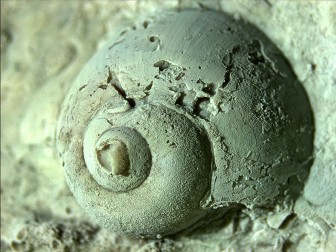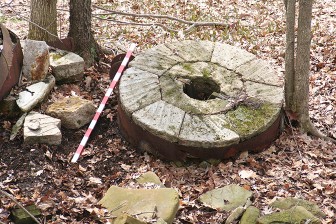
Latex impression of a freshwater snail found in a French buhr millstone at Lanterman’s Mill, Youngstown, Ohio. Image: Cleveland Museum of Natural History
If only rock could talk.
Well it can, scientists at the Cleveland Museum of Natural History have discovered.
At least that’s true about rock — some of it 300 million years old — used to make millstones for gristmills in Ohio.
Actually, it’s the fossils in the stone that do the talking. And this is what they’ve told the scientists:
Some of the millstones under study were made of Ohio chert, or flint, from about 300 million years old and contain saltwater marine fossils typical of the later Paleozoic era.
But others were made of buhr imported from France in the 18th century, and a mere 2.6 million to 65 million years old, according to a recent study.
The two types of rock look similar in color.

Latex impression of a freshwater snail found in a French buhr millstone at Lanterman’s Mill, Youngstown, Ohio. Image: Cleveland Museum of Natural History
Millers preferred the French buhr because it was better than native Ohio chert for cutting grain that sifted more easily to make white flour, said Joseph Hannibal, the museum’s curator of invertebrate paleontology. He is the lead author of the study published in PALAIOS, the journal of the Society for Sedimentary Geology.
“The story of the importation of this stone from France is not widely known,” Hannibal said.
Millstones, the study said, “are key geological components of material culture” and are still in use, although in far fewer numbers than in the 1700s and 1800s.
“Millstones made of Ohio chert were exported outside of Ohio to other states,” from Pittsburgh to the Mississippi River, “and French millstones have been distributed worldwide,” the study said. “Contemporary advertisements show that millstones made of French buhrstone were highly desirable and commanded high prices,” it said.
Native chert like that found in Ohio was quarried elsewhere in the United States as well, including Indiana, and ads for millstones made from it were generally less prominent than ads for ones made from imported French stone.
Researchers, including college and high school students, conducted a five-year study at 60 sites in about 30 counties in Ohio, examining several hundred millstones. The team used hand lenses and a binocular field microscope to inspect the millstones for fossils.
The museum said the study is part of a broader project examining the geology of millstones and the trans-Atlantic stone trade.